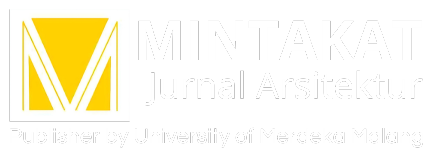KAJIAN TIPOLOGI RUANG PESANTREN BAGI SANTRI DISABILITAS INTELEKTUAL
DOI:
https://doi.org/10.26905/jam.v23i1.6062Keywords:
Disabilitas Intelektual, Pesantren, Ruang, SantriAbstract
Pesantren pada umumnya adalah tempat para santri belajar agama dan ilmu umum dalam lingkup bermukim. Namun, dalam psikososial ranah pesantren saat ini bisa beralih menjadi sebuah objek yang sangat mengganggu apabila yang bermukim adalah santri berkebutuhan khusus yakni disabilitas intelektual. Kajian ini akan mengupas bagaimana seharusnya elemen pembentuk ruang pesantren bagi disabilitas intelektual, dengan membandingkan tipologi ruang pesantren untuk santri normal berdasar desain berbasis manusia sebagai tolak ukur keberhasilan bagi pengguna yakni disabilitas intelektual. Pada akhir jurnal ini, akan ditemukan beberapa aspek elemen tipologi ruang yang berdasar strategi arsitektural yang harus diterapkan pada pesantren yang memiliki santri disabilitas intelektual.
Islamic boarding schools in general are places where students learn religion and general science within the scope of living. However, in the psychosocial realm of Islamic boarding schools today, it can turn into a very friendly object, which are students with special needs, namely intellectual disabilities. This study will examine how the design of pesantren spaces for intellectual disabilities should be, by comparing the typology of Indonesian pesantren spaces based on human-based designs as a benchmark for trust for users with intellectual abilities. In this final journal, we will find several aspects of architectural strategies that must be applied to Islamic boarding schools with intellectual disabilities.
Downloads
References
Dhofier, Z. (1983). Tradisi Pesantren Studi tentang Pandangan Hidup Kyai, LP3S. Jakarta.
Ervin, D. A., Hennen, B., Merrick, J., & Morad, M. (2014). Healthcare for persons with intellectual and developmental disability in the community. Frontiers in Public Health, 2, 83.
Huberty, T. J. (2012). Anxiety and depression in children and adolescents: Assessment, intervention, and prevention. Springer Science & Business Media.
Jankowicz-Szymanska, A., Mikolajczyk, E., & Wojtanowski, W. (2012). The effect of physical training on static balance in young people with intellectual disability. Research in Developmental Disabilities, 33(2), 675–681.
McMahon, S. D., Wernsman, J., & Rose, D. S. (2009). The relation of classroom environment and school belonging to academic self-efficacy among urban fourth-and fifth-grade students. The Elementary School Journal, 109(3), 267–281.
Morrison, C.-A., Woodbury, E., Johnston, L., & Longhurst, R. (2020). Disabled people’s embodied and emotional geographies of (not) belonging in Aotearoa New Zealand. Health & Place, 62, 102283.
Nousiainen, M., Lindroos, H., & Heino, P. (2016). Restorative environment design.
Pinazo, E. P., & Reina, M. C. (2017). A model to enhance interaction for people with severe intellectual disability in healthcare, education and interpreting. Procedia-Social and Behavioral Sciences, 237, 1189–1195.
Simó-Pinatella, D., Alomar-Kurz, E., Font-Roura, J., Gine, C., Matson, J. L., & Cifre, I. (2013). Questions about behavioral function (QABF): Adaptation and validation of the Spanish version. Research in Developmental Disabilities, 34(4), 1248–1255.
Szumski, G., & Karwowski, M. (2012). School achievement of children with intellectual disability: The role of socioeconomic status, placement, and parents’ engagement. Research in Developmental Disabilities, 33(5), 1615–1625.
Taylor, W. (2019). Enhancing the Learning Environment. In Future Schools: Innovative Design for Existing and New Buildings (pp. 127–144). RIBA Publishing London.
Thoring, K., Goncalves, M. G., Mueller, R. M., Badke-Schaub, P., & Desmet, P. (2017). Inspiration Space: Towards a theory of creativity-supporting learning environments. In The Design Management Academy 2017 International Conference: Research Perspectives on Creative Intersections (pp. 1539–1561). The Design Research Society.
van den Bosch, K. A., Andringa, T. C., Başkent, D., & Vlaskamp, C. (2016). The role of sound in residential facilities for people with profound intellectual and multiple disabilities. Journal of Policy and Practice in Intellectual Disabilities, 13(1), 61–68.
Von Gontard, A. (2013). Urinary incontinence in children with special needs. Nature Reviews Urology, 10(11), 667–674.
White, S. W., Oswald, D., Ollendick, T., & Scahill, L. (2009). Anxiety in children and adolescents with autism spectrum disorders. Clinical Psychology Review, 29(3), 216–229.














